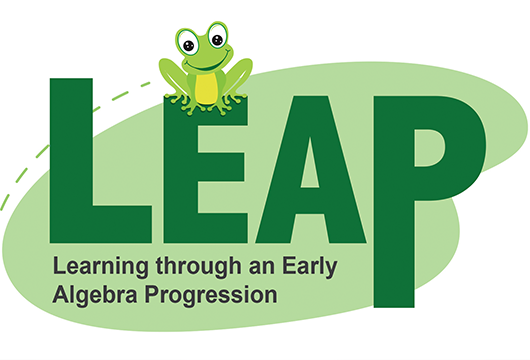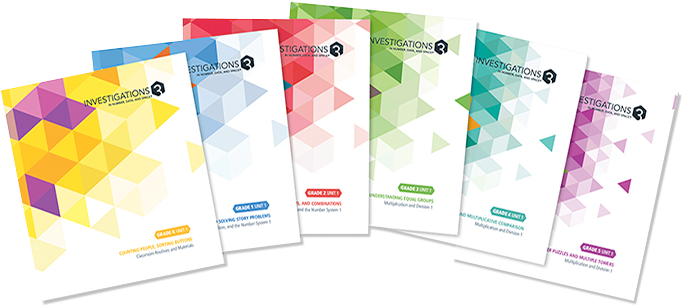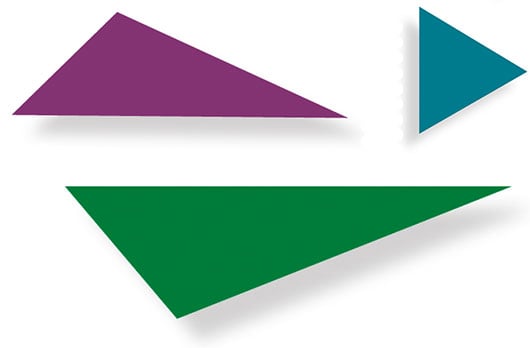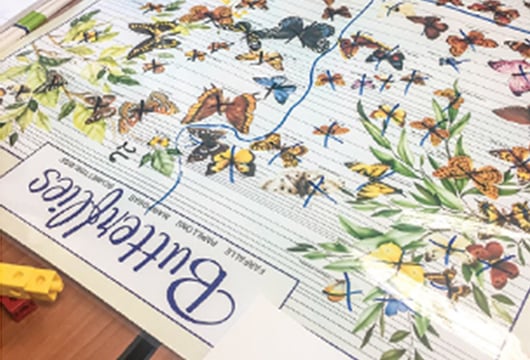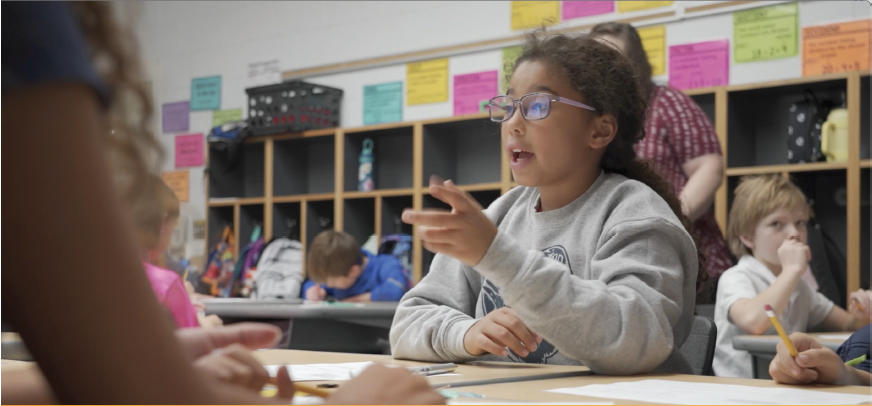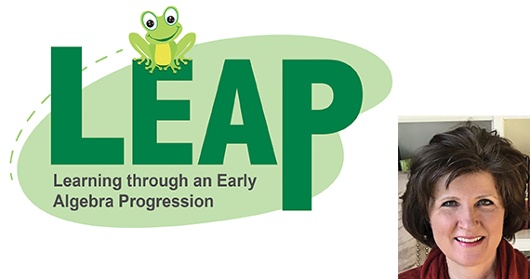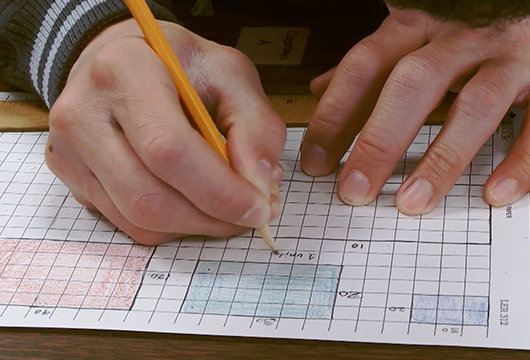TERC Blog
Developing an Effective Curriculum for Early Algebra
Learning standards such as the Common Core State Standards for Mathematics [CCSSM] (NGA Center & CCSSO, 2010) advocate that we develop students’ algebraic thinking beginning in kindergarten. Such a tall order requires innovative approaches that re-imagine what teaching and learning mathematics means for the elementary grades. But why would we want to teach algebra to children as young as age 5? The answer to that lies in understanding what we mean by algebra in the elementary grades—or, early algebra.
What Algebra Means for Young Learners
Early algebra can be thought of as a set of four algebraic thinking practices: generalizing, representing, justifying, and reasoning with mathematical structure and relationships (Blanton & Gardiner, 2018; Hands On!). From this perspective, early algebra is less about something to do (such as solving equations) and more about ways to think that involve general mathematical claims. It means noticing that the sum of any two odd numbers is even and building arguments that show why. It involves noticing and representing a relationship between two quantities using words or variable notation, or reasoning relationally with the equal sign to find an unknown value in an equation. It includes understanding how operations behave and using this to compute efficiently.
This might sound familiar. These are all forms of mathematical reasoning that can—and sometimes do—occur in elementary grades. Yet older approaches to teaching elementary grades mathematics have focused on arithmetic content and treated it as distinct from—and to be taught “before”—algebra. Early algebra turns this approach on its head through two core assumptions: (1) young learners cannot fully understand arithmetic apart from algebra; and (2) arithmetic in the elementary grades is a natural setting in which students can begin to think algebraically.
Why We Need Effective Early Algebra Resources for Elementary Grades
Early algebra can help mitigate the excessive failure rates in high school algebra that have resulted from older “arithmetic-then-algebra” approaches. This is no small task. Important initiatives—through focused funding opportunities and state-wide policy goals—are bringing new weight to addressing algebra’s historic “gatekeeper effect” (Schoenfeld, 1995). But we also need new curricula that use fresh approaches to what it means to “do” algebra in the elementary grades. Even widely adopted elemementary curricula have significant gaps in their treatment of early algebraic concepts (Blanton et al., 2019). For example, a relational understanding of the equal sign is a core concept in algebra (and arithmetic). However, this concept is usually addressed primarily in first grade, even though students’ operational misconceptions about the equal sign persist throughout elementary and middle grades (Stephens et al., 2013) in ways that can impact their success in algebra (Knuth et al., 2006).
 To address these gaps we developed the LEAP curriculum, an early algebra curriculum for Grades K–5 that can supplement any existing elementary grades mathematics curriculum. To illustrate this, Table 1 compares the treatment of algebraic thinking practices in LEAP (Grades K–2) with one widely adopted curriculum. LEAP builds young learners’ ability to generalize, represent, justify, and reason with the mathematical relationships embedded in arithmetic content they encounter in elementary grades, with an eye towards the algebra content they will encounter later. Tested in classrooms with diverse learners, LEAP’s inclusive approach can improve educational outcomes for all students (Blanton et al., 2019): research shows that students who were taught the LEAP curriculum as part of their regular mathematics instruction in elementary grades were significantly better prepared for algebra upon entering middle grades (Blanton et al., 2019; Stephens et al., 2021).
To address these gaps we developed the LEAP curriculum, an early algebra curriculum for Grades K–5 that can supplement any existing elementary grades mathematics curriculum. To illustrate this, Table 1 compares the treatment of algebraic thinking practices in LEAP (Grades K–2) with one widely adopted curriculum. LEAP builds young learners’ ability to generalize, represent, justify, and reason with the mathematical relationships embedded in arithmetic content they encounter in elementary grades, with an eye towards the algebra content they will encounter later. Tested in classrooms with diverse learners, LEAP’s inclusive approach can improve educational outcomes for all students (Blanton et al., 2019): research shows that students who were taught the LEAP curriculum as part of their regular mathematics instruction in elementary grades were significantly better prepared for algebra upon entering middle grades (Blanton et al., 2019; Stephens et al., 2021).

Building Students’ Algebraic Understanding with LEAP
Through 18–20 hands-on lessons for each of Grades K–5, the LEAP curriculum uses a spiraled approach that expands and deepens the treatment of the four algebraic thinking practices across elementary grades. Lessons are spaced throughout each year to allow for reflection and growth. Figure 1 provides an overview of the components of a LEAP lesson. LEAP uses a variety of strategies to develop students’ understanding of core early algebraic concepts and practices. Let’s look at some of these.

Encouraging Good Classroom Norms
LEAP lessons are built around cognitively demanding tasks that support children’s mathematical sense making. The ways in which students participate in math classrooms is critical to this. Beginning in kindergarten, LEAP lessons encourage students to actively explain their thinking, to provide good arguments, and to challenge each others’ ideas. Such norms are foundational to building students’ understanding. For example, in one Grade 1 lesson, partner groups are asked to consider and discuss the meaning of “even” and “odd” using concrete and visual tools and without counting the cubes (see Figure 2).

Through simple tasks such as this, teachers can build rich discussions in which students share their ideas and think about and challenge other ideas. In our experience, rich math discussions in elementary grades allow students to discuss new concepts and compare their ideas and strategies to those of their peers, deepening their mathematical understanding. Engaging in mathematical discussions with young learners shows them that there isn’t always one way to think about a problem.
Revisiting Core Algebraic Concepts and Practices Across Grades
It takes time for students to deeply understand any concept. Early algebra content is no different. LEAP continually revisits core algebraic practices and concepts across elementary grades. Over time, students develop strong understandings about how to notice, represent, justify, and reason with general mathematical claims, using increasingly sophisticated representations. For example, in kindergarten, children begin to think informally about important properties such as commutativity, even before operational symbols such as + are introduced (see Figure 3). As students advance in arithmetic work across elementary grades, they begin to generalize these properties, first representing them in words that make sense to them, then in variable notation. They build representation-based arguments (Schifter, 2009) for why their claims about operations are true and they reason with these properties to compute more efficiently.

Figure 4 illustrates this with a portion of the “Explore and Discuss” from a Grade 3 lesson that uses true/false and open equations as a context for exploring the commutative property of addition.

Using Concrete and Visual Tools To Support Learning
LEAP lessons layer the use of tools from concrete to visual to abstract (Witzel & Little, 2016) to help students make sense of algebraic concepts (see Figure 5). This is particularly important for younger learners.

Lessons also incorporate visual tools to help students transition from concrete to abstract thinking. For example, in reasoning about whether the sum of two numbers is even or odd, students transition from Unifix Cubes® to visual representations of evens and odds using “circle cards” (see Figure 6).

Incorporating Teacher Support in LEAP Lessons
The LEAP curriculum embeds important teaching strategies into each lesson (see Figure 7). Lessons also include research-based insights into students’ thinking about algebraic ideas, including misconceptions they have and how to address these through instruction. Support materials provide teachers with guidance on how to develop key ideas or use essential teaching practices and how to use various concrete and visual tools to promote learning. They also provide information on the different mathematical conventions or vocabulary students might encounter in lessons. Guided question prompts are included throughout each lesson to help teachers build rich classroom discussions (for example, see Figure 4). Multiple formative assessments are included for each grade to measure students’ progress.

Conclusion
Effective, research-based curricula such as the LEAP curriculum can bridge the transition from old ways of doing mathematics to new ways of thinking that can improve all students’ success in school mathematics. Our research has shown that LEAP Grades 3–5 significantly improves children’s algebra readiness for middle grades (Blanton et al., 2019) and that these students retain their advantage as they progress through middle grades (Stephens et al., 2021). Our recently completed LEAP Grades K–2 curriculum shows similar potential. Our next goal is to study the LEAP Grades K–2 curriculum’s effectiveness and how we can best support teachers in implementing LEAP across elementary grades.
Learn More About Project LEAP and the LEAP Curriculum
Please contact us if you are interested in partnering with us in our research or visit our website (terc.edu/projects/project-leap/) to learn more about the LEAP early algebra curriculum and how you can use it in your school or district.
Author Bios
Maria Blanton is a Senior Scientist at TERC. Her expertise in developing early algebra learning progressions and interventions that support children’s algebraic thinking has led to numerous federally funded research projects and journal publications. She is co-editor of the research volume Algebra in the Early Grades (2008, Taylor/Francis) and author or co-author of practitioner-oriented books, including Algebra and the Elementary Classroom (2008, Heinemann), Developing Essential Understanding of Algebraic Thinking for Teaching Mathematics in Grades 3–5 (2011, NCTM), and Teaching with Mathematical Argument (2018, Heinemann). She received the 2020 International Award for Interdisciplinary Excellence in Mathematics Education (Texas A&M University) in recognition of her early algebra research. Maria_Blanton@terc.edu
Angela Murphy Gardiner is a Research and Design Specialist at TERC. A former elementary classroom teacher, she brings extensive expertise in implementing early algebra interventions and has led classroom implementations of early algebra interventions across the principal investigator’s federally funded K–5 projects. She has extensive experience leading teacher professional development and in school-based data collection. She has published widely and has led presentations at the National Council of Teachers of Mathematics Annual Conference and elsewhere on transforming early algebra research for practitioner audiences. Angela_Gardiner@terc.edu
Acknowledgement
The research reported here was supported by the U.S. Department of Education under IES (Institute of Education Sciences) Award #R305A170378. Any opinions, findings, and conclusions or recommendations expressed in this material are those of the authors and do not necessarily reflect the views of the U.S. Department of Education.
References
Blanton, M., Brizuela, B., Stephens, A., Knuth, E., Isler, I., Gardiner, A., Stroud, R., Fonger, N., & Stylianou, D. (2018). Implementing a framework for early algebra. In C. Kieran (Ed.), Teaching and learning algebraic thinking with 5- to 12-year-olds: The global evolution of an emerging field of research and practice (pp. 27–49). Springer.
Blanton, M., Gardiner, A., Stephens, A., & Knuth, E. (2021a). LEAP: Learning through an Early Algebra Progression (Grade 3). Didax, Inc.
Blanton, M., Gardiner, A., Stephens, A., & Knuth, E. (2021b). LEAP: Learning through an Early Algebra Progression (Grade 4). Didax, Inc.
Blanton, M., Gardiner, A., Stephens, A., & Knuth, E. (2021c). LEAP: Learning through an Early Algebra Progression (Grade 5). Didax, Inc.
Blanton, M., Gardiner, A., Stephens, A., & Knuth, E. (2022a). LEAP: Learning through an Early Algebra Progression (Grade K). Didax, Inc.
Blanton, M., Gardiner, A., Stephens, A., & Knuth, E. (2022b). LEAP: Learning through an Early Algebra Progression (Grade 1). Didax, Inc.
Blanton, M., Gardiner, A., Stephens, A., & Knuth, E. (2022c). LEAP: Learning through an Early Algebra Progression (Grade 2). Didax, Inc.
Blanton, M., Stroud, R., Stephens, A., Gardiner, A., Stylianou, D., Knuth, E., Isler, I., & Strachota, S. (2019). Does early algebra matter? The effectiveness of an early algebra intervention in grades 3–5. American Educational Research Journal, 56(5), 1930–1972.
Knuth, E. J., Stephens, A. C., McNeil, N. M., & Alibali, M. W. (2006). Does understanding the equal sign matter? Evidence from solving equations. Journal for Research in Mathematics Education, 37, 297–312. doi:10.1207/s1532690xci2403_3
National Governors Association Center for Best Practices & Council of Chief State School Officers. (2010). Common core state standards for mathematics. Council of Chief State School Officers. Retrieved from https://corestandards.org/mathematics-standards/
Schifter, D. (2009). Representation-based proof in the elementary grades. In D. Stylianou, M. Blanton & E. Knuth (Eds.), Teaching and learning proof across grades: A K–16 perspective (pp. 71–86). New York, NY: Routledge.
Schoenfeld, A. H. (1995). Report of Working Group 1. In C. Lacampagne, W. Blair & J. Kaput (Eds.), The algebra colloquium: Vol. 2. Working group papers (pp. 11–18). U.S. Department of Education, Office of Educational Research and Improvement.
Stephens, A., Knuth, E., Blanton, M., Isler, I., Gardiner, A., & Marum, T. (2013). Equation structure and the meaning of the equal sign: The impact of task selection in eliciting elementary students’ understandings. Journal of Mathematical Behavior 32(2), 173–182.
Stephens, A. C., Stroud, R., Strachota, S., Stylianou, D., Blanton, M., Knuth, E., & Gardiner, A. M. (2021). What early algebra knowledge persists one year after an elementary grades intervention? Journal for Research in Mathematics Education, 2(3), 332–348.
Witzel, B. S., & Little, M. E. (2016). Teaching elementary mathematics to struggling learners. New York: The Guilford Press.






